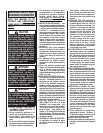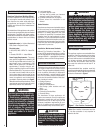
4
NOTE: DIAGRAMS & ILLUSTRATIONS ARE NOT TO SCALE
PLANNING YOUR INSTALLATION
SELECTING A LOCATION
The design of your home and where you place
your stove will determine its value as a source
of heat. This type of appliance depends primarily
on air circulation (convection) to disperse its
heat, and therefore, a central location is often
best. There are other practical considerations,
which must be considered before a fi nal selec-
tion of locations is made.
• Existing Chimneys
• Pellet Fuel Storage
• Aesthetic Considerations
• Roof Design (rafter locations and roof
pitch)
• Room Traffi c
• Proximity to Combustibles
• Electrical Wiring
The installation of these appliances will
require some research. Once your options are
determined, consult with your local building
department who will be able to give you the
necessary installation requirements for your
area (Is a building permit required? Rooms
where installation may not be allowed, etc.).
FLOOR PROTECTION
WARNING
Electrical grounding instructions:
This appliance is equipped with
a three-prong (grounding) plug
for your protection against shock
hazard and should be plugged
directly into a properly grounded
three-prong receptacle. Do not
cut or remove the grounding
prong from this plug. Do not route
power cord under or in front of
appliance.
Questions To Ask Local Building Offi cial
A correct installation is critical and imperative
for reducing fi re hazards and perilous condi-
tions that can arise when wood pellet burn-
ing appliances are improperly installed. The
installer must follow all of the manufacturers’
instructions.
The installation of this appliance must conform
to local codes and applicable state and federal
requirements. Familiarity with these require-
ments before installation is essential. Important
considerations to discuss with local building
offi cials include:
1. Applicable codes (i.e. Uniform Mechanical
Code, State or Regional Codes).
Electrical codes:
In USA, NEC, ANSI / NFPA 70 – Latest Edi-
tion
In Canada, CSA C22.1 – Latest Edition
Power Supply Requirements – The power
cord must be plugged into a standard, 120
Volt, 60 Hz grounded electrical outlet. The
approximate power requirement is 362
Watts, and will peak up to 736 Watts for
approximately 6 minutes when the self-
igniter is operating (it will turn off 2 minutes
after fl ame detection). The power cord must
be routed to avoid contact with any of the
hot or sharp exterior surface areas of the
stove. When installed into a manufactured
home, the appliance must be electrically
grounded to the steel chassis (see Page 8,
Manufactured Home Requirements). These
requirements must be met unless otherwise
specifi ed by state or local authorities.
2. Local amendments
3. Is a permit required - cost
You may wish to contact your insurance
company to ask if they require this.
4. If outside combustion air is required
5. Rooms where the installation is not
allowed
Smoke Detectors
Since there are always several potential sources
of fi re in any home, we recommend installing
smoke detectors. If possible, install the smoke
detector in a hallway adjacent to the room
(to reduce the possibility of occasional false
activation from the heat produced by these
appliances). If your local code requires a smoke
detector be installed within the same room, you
must follow the requirements of your local code.
Check with your local building department for
requirements in your area.
Installation / Maintenance Standards
National Fire Protection Association – The
primary NFPA standard that refers to installa-
tion and maintenance of pellet appliances and
venting is NFPA 211 – Latest Edition: Chimneys,
Fireplaces, Vents, and Solid Fuel appliances.
Floor Protection - Profi le
®
20 FS-2
This appliance requires noncombustible fl oor
protection. If the fl oor protection is to be stone,
tile, brick, etc., it must be mortared or grouted
to form a continuous non-combustible surface.
If a chimney connector extends horizontally
over the fl oor, the protection must cover the
fl oor under the connector and at least 2” to
either side.
A noncombustible fl oor protector must fully
cover the area beneath the appliance and extend
6” to the front, 6” to the sides, and up to 6” from
the back as illustrated in Figure 1.
Rear
Front
Floor
Protector
Up to * 6” (153 mm)
minimum
6”
(153 mm)
min.
6”
(153 mm)
min.
6” (153 mm)
min.
WARNING
Check all local building and
safety codes before installation.
The installation instructions and
appropriate code requirements
must be followed exactly and
without compromise. Alterations
to the stove are not allowed.
Do not connect the stove to a
chimney system serving another
stove, appliance, or any air dis-
tribution duct. Failure to follow
these instructions will void the
manufacturers warranty.
CAUTION
These appliances are very heavy.
The use of a heavy duty escalara
(stair step hand truck) is recom-
mended for lifting the appli-
ance.
Figure 1 - Floor Protction, Freestanding
*Note: When installed at clearances less than
6”, the fl oor protection is only required to
extend to the wall.
Top View


















